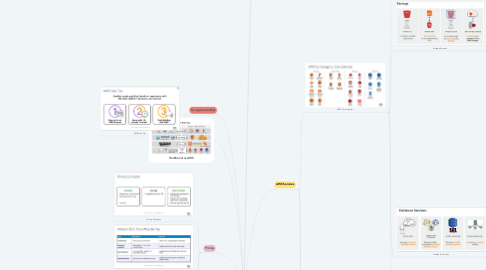
1. AWS Compute Offerings
1.1. Server
1.1.1. EC2
1.1.1.1. Common Use Cases: •Big data (e.g. Hadoop, Spark) •Database software (e.g., Aurora, DynamoDB) •Enterprise applications (e.g., SAP, Oracle, Sharepoint) •Migrations from on-premises environments, including BYOL •Open-source cluster management
1.1.2. Lightsail
1.1.2.1. Common Use Cases: •Simple web applications •Websites, including custom code, WordPress, and eCommerce •Single-server business software •Dev/Test environments •All-in-one solution, including instances, load balancers and databases
1.1.3. Elastic Beanstalk
1.1.3.1. Common Use Cases: . Application which has smaller lifecycles . Simple and less complex applications
1.2. Containers
1.2.1. Elastic Container Service
1.2.2. Elastic Kubernetes Service
1.2.3. Common Use Cases: •Machine learning •Microservices •Batch processes •Web applications
1.3. Serverless
1.3.1. Lambda
1.3.2. Fargate
1.3.3. Amplify
1.3.4. Amazon Aurora Serverless
1.3.5. Common Use Cases: •Web applications •Mobile backends •IoT backends •Stream processing workloads •File processing workloads
2. Pricing
2.1. Pricing Concepts
2.2. EC2
2.3. EBS Pricing
3. Traditional vs AWS
4. To explore further
4.1. AWS Free Tier
5. AWS Global Infrastructure
6. AWS Management Interfaces
6.1. AWS Console
6.2. AWS Command Line Interface (CLI)
6.3. SDKs
7. AWS Services
7.1. AWS Core Services
7.1.1. Compute Services
7.1.1.1. EC2
7.1.1.2. AMI
7.1.1.3. Instance Types
7.1.1.4. EC2 Purchasing Options
7.1.2. Storage Services
7.1.2.1. S3
7.1.2.2. S3 Facts
7.1.2.3. Common Services
7.1.2.4. Lifecycle Policies
7.1.2.5. S3 Storage
7.1.3. Database Services
7.1.3.1. RDS
7.1.3.2. RDS
7.1.3.3. DynamoDB
7.1.3.4. RDS & DynamoDB
7.1.3.5. Considerations
7.1.4. Networking Services
7.1.4.1. VPC
7.1.4.2. VPC
7.2. Platform Services
7.2.1. Analytics
7.2.2. Mobile Services
7.3. Developer and Operations Services
7.3.1. Management Tools
7.3.2. Security
7.3.2.1. Security Services
7.3.2.2. Operations
